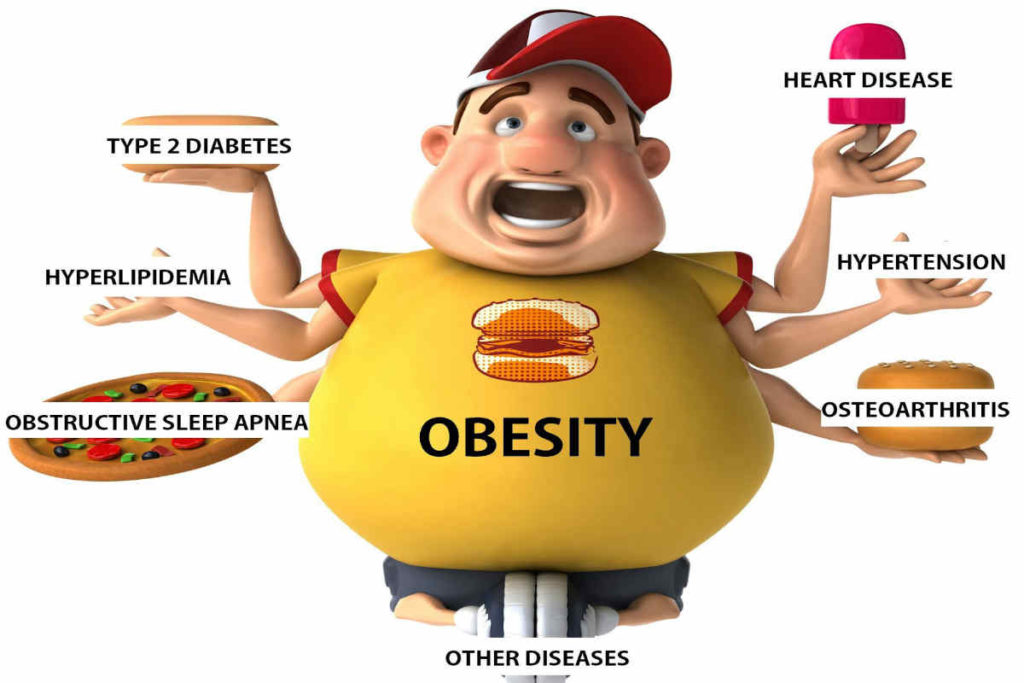Question and Answer Session


Childhood obesity is becoming common these days. Eating unhealthy and less nutritious food is a major contributing factor. India has the second largest number of obese children in the world and it is estimated that by 2025 this number is estimated to grow by 70 million. On one hand many children in our country are deprived of right amounts of foods, on the other hand some children are facing obesity as a major concern.
According to Mona – “Childhood obesity results primarily due to limited or no outdoor activity, high calorie intake and irregular eating habits of children.”
In Indian society a chubby child is regarded as healthy. Whereas a chubby child does not mean that the child is healthy.
Childhood Obesity Complications
Childhood obesity can lead to serious complications such as:
Mona says- “Childhood obesity is not a result of genetics, whereas it is actually a result of parent’s behavior, if parents are eating unhealthy the child will mimic the same and ultimately becomes obese as his/her parent.”
Right Food for Obese Children
Mona does not recommend low fat food in children as the process of making a low fat food involves extracting the fat content and replacing it with refined carbohydrates to make it palatable. Refined carbohydrates are bad for the health and causes obesity.
Mona says- “Combine the foods to make it more nutritious and healthy. Example-If you are giving aloo parantha to child club it with yogurt and butter to make it more nutritious. Instead, try giving a vegetable parantha like gobhi or mooli parantha.”
Food During Exams
As parents we feed the child with whatever food he/she asks for especially during the exam time. Mona says -It is important to replace high carbohydrate food with foods rich in phytonutrients, omega- 3 fatty foods, extra virgin olive oil, and antioxidants.
These foods supplement optimum nutrition and improve the performance of the child. Foods high in carbohydrates kill gut micro biome.
Value of Rainbow Food
Mona suggests eating rainbow foods at an early age to all children. This includes eating different colored fresh fruits and vegetables. This supplies children with essential phytonutrients, vitamins and minerals. Eating unprocessed foods, fatty fish (a rich source of omega-3), and cereals aids healthy nutrition in children
Power Food-Simple and Easy Early Breakfast Recipe
Berry smoothie- Make simple smoothie which contains flax seeds, berries, yogurt and little bit of honey. This is an ideal food for kids, as it contains good combination of macros.
Foods to Completely Avoid
Below is the list of some foods which are to be completely avoided
Foods to be Given to Children in Moderation
Food Essential for Growth and Development
Mona says- “Calcium is one mineral essential during early development years. Maximum calcium requirement is there during 9-18 years of age. 1000 mg/day is the essential requirement of the child during this phase.”
Foods rich in calcium are
To read more on Obesity, click on the link below.

Obesity is a multifaceted health disorder that affects both adults and children. Being obese not only affects the overall persona of an individual but also increases the risk for many health concerns. An obese person is at a higher risk of developing health conditions like diabetes, heart disease, stroke, arthritis, breathing problems, and some cancers.
Statistics have revealed that obesity is a major factor contributing factor for metabolic syndrome and type 2 diabetes mellitus (T2DM) among Asian Indians. Various factors contribute towards making an individual obese. Some major factors which contribute towards obesity are environment, family history and genetics, metabolism or the way your body converts food and oxygen into energy, and individual’s lifestyle. Besides these factors certain medical conditions also leads to obesity. Scientists are also trying to understand that some chemicals in the environment may be playing in the growing obesity problem.
Recent guidelines have revealed that 10-15% of Indian population would fall under the obese category and would need appropriate management. Purpose of these guidelines on countrywide basis projects an alarming situation of T2DM and cardiovascular disease.
Some startling facts about obesity:
New guidelines have been proposed in view of alarming situation of obesity among Indians. These guidelines have been prepared by 100 medical experts all across the country hailing from the backgrounds of internal medicine, diabetes, metabolism, endocrinology, nutrition, cardiology, exercise physiology, sports medicine, bariatric surgery and representing reputed medical institutions, hospitals, government funded research institutions. The very need for these guidelines has been enumerated below:
Three parameters which are used to measure obesity are body mass index BMI, waist circumference WC and waist-to-hip circumference ratio (WHR). The most accepted method to define thinness and fatness is BMI, a ratio of weight in kilograms divided by height in meters squared (kg/m2).
After a major consensus among scientists below table has been prepared to depict the obesity among Asian Indians:
| Classification | BMI(kg/m2) | |
| Principal cut-off points | Cut-off pointsfor Asians | |
| Normal range | 18.5 – 24.9 | 18.5 – 22.9 |
| 23.0 – 24.9 | ||
| Pre-obese | 25.0 – 29.9 | 25.0 – 27.4 |
| 27.5 – 29.9 | ||
| Obese (Class I) | 30.0 – 34.9 | 30.0 – 32.4 |
| 32.5 – 34.9 | ||
| Obese (Class II) | 35.0 – 39.9 | 35.0 – 37.4 |
| 37.5 – 39.9 | ||
| Obese (class III) | ≥40.0 | ≥40.0 |
Research has revealed that abdominal obesity is associated with higher risk of diabetes and cardiovascular disease when compared with generalized obesity. Cardiovascular disease is associated with increased amounts of excess abdominal adipose tissue, both intra-abdominal adipose tissue (IAT) and subcutaneous adipose tissue (SCAT). In view of this a joint discussion and consensus among scientists concluded the WC cut off among Asian Indians as defined below:
Obesity could be genetic, behavioral and can also result due to the hormonal changes in the body. Obesity occurs when you take in more calories than you burn through exercise and normal daily activities. Your body stores these excess calories as fat. Some medical conditions also result in obesity such as Prader-Willi syndrome, Cushing’s syndrome, and other diseases and conditions. The main reasons for obesity are either sedentary lifestyle or eating unhealthy such as junk foods at wrong intervals.
What are the risk factors that can contribute to obesity?
Obesity usually results from a combination factors, including:
What are the complications associated with obesity?
A number of health problems arise if you are obese. Some of the diseases which you may encounter include:
Quality of life-If you are obese you are most likely to suffer from other issues, which can severely affect the quality of life. Some common problems which arise due to obesity include depression, disability, sexual problems, shame and guilt, social isolation, and poor performance at workplace
You can take some below-mentioned steps to prevent obesity:
According to joint decision among scientist below is the list of guidelines about physical activity in combating obesity and associated health concerns:
What is the treatment of obesity?
The treatment of obesity includes a combination treatment from a dietitian, behavior counselor or an obesity specialist. Recent guidelines suggest identifying and treating the underlying cause of obesity, lifestyle modification, pharmacological treatment like ant-obesity drugs along with lifestyle modification, and if needed surgical treatment is advisable in treating obesity.
Scientists have concluded that anti-obesity drugs should be prescribed in combination with dietary and lifestyle changes as a part of comprehensive weight loss program. Also, drug treatment should be monitored on an ongoing basis for efficacy as well as safety. In general, anti-obesity drugs should be administered for BMI above 27 kg/m2 or a BMI above 25 kg/m2
Anti-obesity drugs which are recommended to treat obesity are sibutramine, orlistat should be used as a second line therapy. At times metformin and exenatide can be used under special clinical conditions.
Over the past few years bariatric surgery has come out as an option for obesity reduction. Bariatric surgery involves an alteration in the digestive system by reducing the gastric volume or by changing the path of food bolus which can lead to malabsorption. According to current international guidelines below are the guidelines for bariatric surgery:
Various surgical options are available under the umbrella of surgery which includes:
Pros and Cons are associated with above mentioned procedures; however, it is upon the physician to decide that which surgical treatment is best suited for the particular patient.
Having a positive attitude towards weight loss and employing various changes in lifestyle such as exercising and eating a well-balanced diet can help you to lose weight. Nevertheless, obesity remains a rampant problem even in developing nation like India. Appropriate interventions are required in a timely manner to combat this problem to prevent other major health concerns.
These inspiring stories of those who have overcome Diabetes will keep you motivated
As Hippocrates rightly said centuries ago – “Let food be thy medicine and medicine be thy food.” Here we bring you a realm where our food and nutrition expert Dr. Mona Johar tells us about treating food as medicine in a very easy and simple way.

Comforting a Crying Baby by Famhealth
Babies have crying bouts throughout the first year as this is their only means of communicating for food and comfort.
When your baby cries, your first instinct will be to pick them up. While there have been conflicting views on this topic, let your instinct guide you and do not be afraid of spoiling the baby.
Your baby is new to the world and needs to know that you are reliable and always available. However, if you feel that your baby is crying a lot and that it is making you lose patience or get over tired, get in touch with other mothers, self help and support groups or voluntary organizations which can help you find ways to cope. Let’s explore reasons why the baby may cry and what solutions are available to you.
Why Your Baby May Be Crying
If the crying sounds pitiful or different from normal, the baby may be unwell or a blocked nose could be the cause of the problem. Other possible reasons may be:
Ways to Pacify a Crying Baby
Crying is a normal process, which all babies show. However, ask your health care provider if your child is showing continuous bouts of crying in spite of all your efforts. Doctor can perform an examination which can depict some medical condition which you might not be able to figure it out.
To read more on Pregnancy, click on the link below,

A Cancer diagnosis is dreaded and feared yet rarely understood. Even as cancer cases in India and across the world are poised to grow, there continues to be a sense of mystery around it with very little understanding of the causes and cures for an ailment commonly referred to as the Big ‘C.’ A cancer diagnosis is typically followed by intense periods of anxiety, stress, and fear for the patient as well as a caregiver. Cancer fighters recall feelings of shock followed by anger and denial when their cancer is first discovered mostly because of the myths surrounding it.
The questions abound and range from “How can this happen to me?” to “I don’t have any bad habits so why me?” and is inevitably followed by that looming unspoken query, “Can I survive this?” While these questions besiege patients and caregiver, Doctors, Oncologists and Cancer support groups reassure us that a cancer diagnosis is not a death sentence. Given the right circumstances, one can control and even conquer Cancer. Accurate information and a better understanding about Cancer will certainly help reduce negativity around it so that it can be treated like other health conditions. ‘Cancer fighters’ and ‘Cancer thrivers’ have shared their journey with us in the course of this research and echoed the importance of the right information and a stress-free frame of mind to get through the long drawn treatment and overcome the Big ‘C’.
Did You Know?
The Greek word ‘Oncos’ and ‘Carcinos’ are attributed to Hippocrates and refer to a ‘benign swelling’ and a ‘malignant swelling’ respectively.
What is Cancer?
Cancer, a word surrounded by much fear and plenty of uncertainty, refers to an uncontrolled growth of cells that invade and damage normal tissue. These cells may form a mass called ‘tumor’ which could be malignant or benign. A malignant tumor grows and spreads to other parts of the body while a benign tumor could grow but won’t spread.
Signs and Symptoms
Cancer typically distorts normal organs, nerves and blood vessels causing symptoms related to that specific body part. One of the first places that cancer spreads is the lymph nodes – those bean-shaped organs located in clusters in the neck, groin and under the arms.
Though generalized symptoms like fever, fatigue and weight loss are common in cancers that have spread beyond their site of origin it is the size and aggressiveness of cancer that determines its symptoms.
Types of Cancer
Risk Factors
Even though over 75 percent of cancer cases are diagnosed in people aged 55 or older, increased age alone is not a risk factor for cancer. Statistics show that 5 to 10 percent of cancers are genetically inherited and those cancers tend to occur earlier in life.
Risk factors could include genetics (the BRCA genes, for example) lifestyle (such as smoking, diet, and sun-tanning), environmental exposures or the presence of harmful substances. Viral and bacterial infections also lead to certain cancers, such as the hepatitis virus in liver cancer, Helicobacter pylori in stomach cancer and the HPV virus in cervical cancer.
Stages of Cancer
Stage 0: Cancers at this stage are identified according to the location where they initially emerged and multiplied with the resulting tumor not have spread to nearby tissues. The prognosis for Stage 0 cancer is very good and boosting the immune system may reverse cancer.
Stage 1: Small cancerous tumors may have spread to nearby tissue but not beyond, such as the bloodstream or lymph system. “Early stage” cancer prognosis is also quite good with healthy changes preventing its return.
Stage 2 and 3: “Regional spread” indicates that cancer has expanded and embedded into the surrounding tissue. Even though this stage may cause concern, cancer has not spread to other organs in the body.
Stage 4: When cancer spreads from the initial site to other organs or areas of the body, it is referred to as “distant spread” cancer, advanced cancer, or metastatic cancer. Metastasis refers to the spread of cancer cells from the place where they first formed to another part of the body.
Did You Know?
While there is so much fear associated with Cancer, the statistics are not completely hopeless.
1. Nearly 70% of people diagnosed with cancer all over the world live for more than five years.
2. Over 85% of cases of childhood cancer are curable.
3. Even the most resistant cancers, like melanoma, respond to immune-modulating treatments.
Cancerism
Cancer survivors often battle stigma that can be removed through awareness. Noted oncologist Dr Amish Vora of HOPE Oncology clinic in New Delhi cautions against ‘Cancerism’ which is worse than racism and sexism as it is tough to pinpoint. “Cancer is not infectious yet people avoid those who are diagnosed with it and patients often find it difficult to socialize. They may be discriminated against during job interviews or even in relationships,” explains Vora.
Fact Sheet
According to the World Health Organization, the most common types of cancer that kill men in order of frequency are lung cancer, stomach cancer, liver cancer, colorectal cancer and oesophageal cancer. WHO statistics say that the five most common cancers that kill women in order of frequency are breast cancer, lung cancer, stomach cancer, colorectal cancer, and cervical cancer. According to Specialist Oncologist Dr (Col.) R Ranga Rao, 17 lakh new patients are being diagnosed with cancer every year in India which ranks 3rd in cancer cases after China and the US. The data from National Institute of Cancer Prevention Research (NICPR) reports that for every two women newly diagnosed with breast cancer, one woman dies of it in the country, and almost half million deaths happen due to ignorance about the disease. One woman dies of cervical cancer every 8 minutes in India. Nearly one-third of cancers are caused due to tobacco use while alcohol and tobacco together pose higher risks of developing oral and other cancers.
Globocan’s worldwide data states says that there were 14.1 million new cancer cases, 8.2 million cancer deaths, and 32.6 million people living with cancer within 5 years of diagnosis in 2012. 57% (8 million) of those new cancer cases, 65% (5.3 million) of the cancer deaths, and 48% (15.6 million) of the 5-year prevalent cancer cases occurred in the less developed regions. The overall age-standardized cancer incidence rate is almost 25% higher in men than in women with rates of 205 and 165 cases per 100 000 person-years, respectively.
Anti Cancer Diet
Food has an important link to diseases and the focus on building immunity to prevent or to fight cancer (during Chemotherapy) has resulted in research into plant-based diets that seem to help prevent cancer. Some plant chemicals fight cancer cells directly, while others promote a healthy immune system to reduce cancer risk. Fruits, vegetables, chocolate, tea, and wine are considered beneficial as they contain polyphenols. Spices and herbs rich with flavonoids and carotenoids also reduce oxidation and inflammation thus providing multiple benefits.
To read more on Cancer, click on the link below,
Myth: People with diabetes should never have sweets!

Truth: Good news folks! People with diabetes can have sweets occasionally. American Diabetes Association advocates that desserts and sweets are to be relished and consumed on special occasions and festivals albeit, your blood glucose level are under control and you are taking prescribed medicines regularly.
Myth: People with diabetes cannot have juices.

Truth: People with diabetes can very much enjoy fresh juices, but they definitely need to avoid canned and packed juices because of its added sugar content and high glycaemic values.
Myth: People with diabetes cannot have fruits.

Truth: People with diabetes should offcourse have fruits keeping in mind the glycaemic indexes. According to National Institute of health, USA fruits are a very good source of fibres and vitamin C “ascorbic acid”. All citrus fruits are rich source of vitamin C which boosts our immune system to fight against common diseases.
Myth: A big NO-NO to potatoes

Truth: People with diabetes may have potatoes (baked, grilled or steamed) in meals. Potatoes are to be ideally consumed, along with non-starchy vegetables and salads.
Myth: Diabetes diet is a very strict diet

Truth: A Diabetes diet is one of the healthiest diets, and has no hard and fast rule. Diabetes diet can be even followed by people without diabetes. You may select from a variety of options like the Mediterranean, flexitarian, vegan, Ornish to know more refer to Diet options in Famhealth.
Myth: Say no to all carbohydrates and yes to proteins

Truth: Yes carbohydrates do turn into sugars, but having overload of proteins and no carbs may lead to fatigue and cardiovascular diseases. Having more of proteins eventually leads to accumulation of fats in the body leading to cardiovascular diseases. ADA suggests, making a smart choice of having low carbohydrates will keep you energetic and prevent you from feeling low and tired.
Myth: Diabetes diet does not contain eggs, as they contribute to high cholesterol levels in the body

Truth: People with diabetes may have eggs, as eggs are a good source of protein and vitamin D. ADA says, “What really matters is the way it is cooked”. Boiled eggs with yolks removed can be consumed, to ensure that it does not aid to cardiovascular complications.
Myth: You can eat whatever you want if you are taking medications

Truth: This is one of the major myths associated with diabetes. Medications only help you to convert sugar to energy, but if you supplement your body with more than required amount of food then, it will lead to spiking of blood glucose levels and poor diabetes management.
To read more on Diabetes, click on the link below.

Being diagnosed with diabetes can be an overwhelming experience In fact, it can be a major life stress for many people. This is especially true as most chronic conditions and progressive diseases can prove to be quite challenging to manage emotionally.
If you or your family are feeling anxious and disheartened, you should know that it is natural to feel that way. You should also know that you are not alone, and that 70 million other people in India are living with Diabetes. This is a condition that needs to be “managed”.
In brief, Diabetes is characterized by high blood glucose levels that result from defects in the body’s ability to produce enough insulin, and at times no insulin is produced at all. Insulin is required to remove sugars and toxins from our system, and when they do not get flushed out, they tend to accumulate, resulting in high blood glucose levels.
You will be happy to know there are countless cases of people who have reversed their condition simply by making changes in their daily lives, especially when it comes to food, exercise and stress management. With some precautions and care, we are confident that you too can be a winner.
Remember, with a clear plan, appropriate guidance, right (and on time) medications, timely tests and appropriate modifications to your lifestyle you can not only overcome your condition but stay on top of it. To know more, please refer to our Let’s Understand section
Remember, we are here to help you in your endeavour to stay focussed and on target!
As a partner or caregiver, it is understandable that your feel anxious and concerned on hearing the diagnosis of Diabetes.
Please be assured that there is no cause for concern as this is a condition that can be managed with a little care and diligence. You may need to play a pivotal role in the management of the condition for your partner or a loved one and therefore, you would need to be supporting and considerate. Research points to high success rates for diabetics that have had the support of a spouse or family member.
To read more on Diabetes, click on the link below.

Insulin is produced in our body naturally by the pancreatic cells and helps the body in converting sugar into energy. When our body produces insufficient or no insulin then doctors recommend taking Insulin additionally, to ensure body metabolises carbohydrates into sugar, and sugar does not accumulate for a prolonged period of time in the form of blood glucose.
There are myths associated with taking Insulin, read below to find out the most frequently asked questions by people living with diabetes.
Taking Insulin does not necessarily mean that your Diabetes is getting worse. To control your high blood glucose levels your doctor may prescribe Insulin therapy. By not taking the Insulin therapy you may further develop Diabetes-related complications such as Glaucoma in the eyes and malfunctioning of the kidneys or the liver, neuropathy, foot problems, nerve related issues etc. People with Type 2 Diabetes often use combined therapy of medicine and Insulin to keep their sugar levels in control.
Injecting Insulin is not as painful as you may think. Your doctor will direct you how to inject Insulin in the right way and painlessly. Insulin should be given in the areas where one has more flab and less muscle. There are many new types of syringes which are thinner and painless to use, so this should not be a cause for worry.
The answer to this question is different for different types of Diabetes. For people living with Type 1 Diabetes this is true; however, for people with Type 2 Diabetes, studies have shown that taking medication on time, physical exercises and diet control can lead to reversal of the condition. Some people simply do not want to start Insulin because of the fear of having to take it forever. However studies have revealed that once the blood glucose levels are under control, patients have been able to switch back to oral medication and no longer have to depend on Insulin.
Doctors all round the world strongly recommend that people who are Insulin dependent must not miss any injections. If you miss your regular dose, it will disrupt the ground you have gained in Diabetes management and take you back to square one. Your blood sugar levels will shoot up and create an imbalance of toxins in the body, leading to further complications.
It is a good idea to make your own small back-pack where you could keep your syringes, Insulin, cotton, gauze and astringent handy. Insulin has to be kept in a cool place and, hence, sometimes needs to be refrigerated. If you are travelling, check with your pharmacist for new types of Insulin pens and cartridges, which might not need refrigeration.
If your partner has Insulin-dependent Diabetes, we understand that you would have your own set of stresses that can be mentally and physically exhausting. You would need to be able to support your partner in different ways, such as establishing and maintaining a healthy diet and exercise routine, checking your partner for wounds that may be concerning, learning to give Insulin shots correctly and painlessly, as well as routinely check blood glucose levels.
There are quite a few things that you can do to help yourself and your partner. First and foremost, in order to support your partner in living with this condition, you need to take care of yourself, both mentally and physically. Establish a health plan for yourself, which will keep you in good shape to deal with the stresses that go along with Diabetes. It is even better if you can exercise together. Taking up meditation and yoga is also a very good way to reduce the impact of stress on your body.
You do not need to give up your life and pleasures in order to support your partner. For example, develop a balanced diet plan that takes care of your partner’s nutritional requirements, but do not forget to add your favourite dish to the equation!
Consult with your doctor to plan an evening out, away from the regular routine. Understand and follow the doctor’s instructions when it comes to dos and don’ts for eating and drinking on your evening out, and you will be fine.
Make sure to have a backup for yourself. As you support your partner in living with Diabetes, you need not give up your interests. Have family/friends provide you with backup whenever you need to step away for some time. This also takes care of the condition known as “compassion fatigue” in caregivers.
It is also good to have support of other people living with this condition just in case you yourself are under the weather for a couple of days.
To read more on Diabetes, click on the link below.